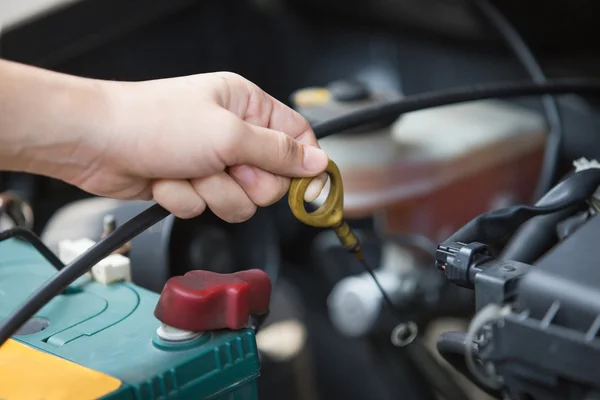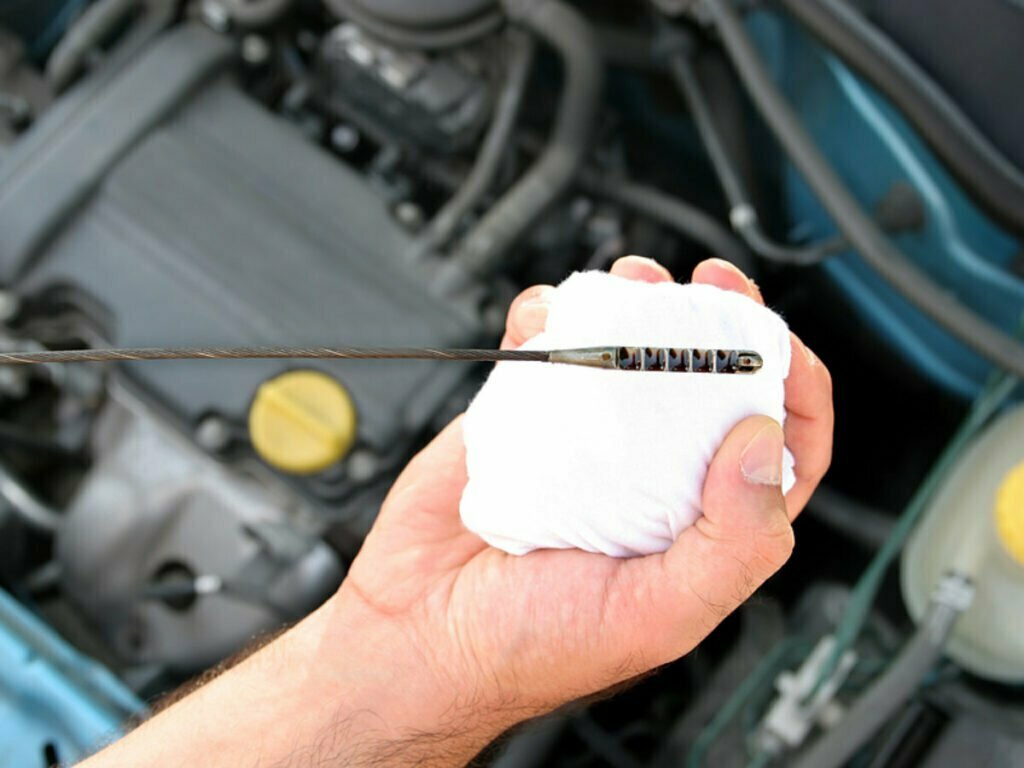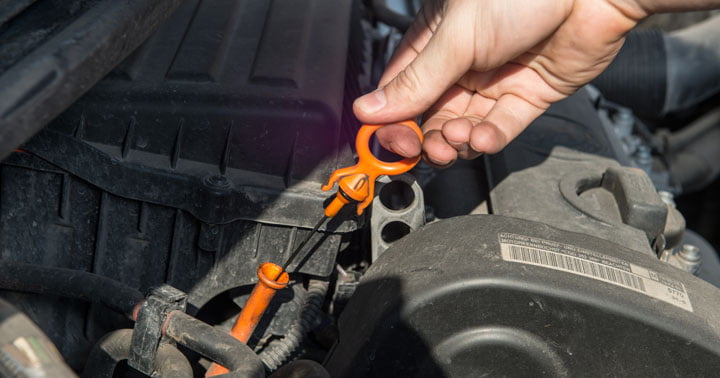Checking your engine’s oil level is an important part of maintaining your vehicle. The engine oil plays a critical role in keeping your engine running smoothly and efficiently, and it is essential to make sure that it is at the correct level. In this article, we will provide a step-by-step guide on how to read an oil dipstick and accurately check your engine’s oil level. By regularly checking your oil level, you can help ensure that your engine stays in good working order and avoid potential problems.
Guide to read an oil dipstick
Locate the oil dipstick
To locate the oil dipstick, you will need to look in your engine bay. It is typically a thin, long rod with a circular loop or handle at one end.
In general, the oil dipstick is usually found near the front of the engine, close to the oil pan. It may be labeled with the word “oil” or a symbol of an oil can. If you are having trouble finding the oil dipstick, you can try looking for the oil fill cap, which is usually located nearby.
Once you have located the oil dipstick, you can proceed to the next steps in the process of checking your engine’s oil level.
Remove the dipstick

To remove the dipstick from the engine, first locate it in your engine bay (as described above). Once you have found the dipstick, grasp the circular loop or handle at the end of the rod and gently pull it out of the engine. Be careful not to damage the dipstick or the engine as you remove it.
Once the dipstick is out of the engine, use a clean, lint-free cloth to wipe off any oil that may be on it. This will help you accurately read the oil level on the dipstick. Make sure to clean both sides of the dipstick, as well as the area where the oil level marks are located.
Reinsert the dipstick
After you have removed the oil dipstick from the engine and cleaned it, you will need to reinsert it fully back into the engine. To do this, hold the dipstick horizontally and carefully guide it back into the engine. Make sure to insert it all the way in, so that it is fully seated.
You may need to use a little bit of force to fully insert the dipstick, but be careful not to apply too much pressure. If you are having trouble inserting the dipstick, make sure it is aligned properly and try gently wiggling it back and forth until it goes in smoothly.
Remove the dipstick again
After you have reinserted the oil dipstick fully into the engine, you will need to remove it again in order to check the oil level. To do this, repeat the steps you used to remove the dipstick earlier: grasp the circular loop or handle at the end of the rod and gently pull it out of the engine. Be careful not to damage the dipstick or the engine as you remove it.
Once the dipstick is out of the engine, hold it horizontally. This will allow you to accurately read the oil level on the dipstick. Make sure to hold the dipstick level and avoid tilting it, as this can give you an inaccurate reading.
Look at the end of the dipstick

After you have removed the oil dipstick from the engine and held it horizontally, you will need to look at the end of the dipstick where the oil level marks are located. These marks are usually indicated by a crosshatched pattern or a series of dots.
To accurately read the oil level on the dipstick, hold the dipstick up to a light source, such as a flashlight or the sun, and look for the oil level marks.
Check the oil level on the dipstick
After you have located the oil level marks on the dipstick, you can check the oil level to see if it is between the “full” and “low” marks. To do this, hold the dipstick horizontally and compare the oil level on the dipstick to the oil level marks.
If the oil level is between the “full” and “low” marks, your engine has the correct amount of oil and you do not need to add any more. If the oil level is below the “low” mark, you will need to add more oil to your engine.
It is important to use the correct type of oil for your vehicle, as specified in your owner’s manual. Using the wrong type of oil can cause problems and damage your engine. Also, be careful not to overfill your engine with oil, as this can also cause problems.
After you have checked the oil level on the dipstick and determined whether you need to add more oil, you can repeat the process as necessary to ensure that your engine’s oil level remains at the correct level.
Why does your engine need the proper level of oil
An engine needs the proper level of oil for several reasons. Oil is essential for lubricating the moving parts of an engine, such as the crankshaft, connecting rods, and pistons. This helps to reduce friction and wear on the engine, allowing it to run smoothly and efficiently.
Oil also helps to cool the engine by transferring heat away from the moving parts. This helps to prevent the engine from overheating, which can cause serious damage. Oil also helps to clean the engine by picking up dirt and debris, and carries it to the oil filter where it can be removed.
Having the proper level of oil in an engine is essential for its smooth operation and longevity. If the oil level is too low, the engine can become damaged due to lack of lubrication and overheating. If the oil level is too high, it can cause excessive wear on the engine and other components. It is important to regularly check the oil level and add oil as needed to keep it within the recommended range.
FAQS
Q: What do the two dots on an oil dipstick mean?
A: The two dots on an oil dipstick typically represent the minimum and maximum oil levels for the engine. The space between the two dots indicates the range in which the oil level should be maintained. If the oil level is below the minimum dot, it means that the engine is low on oil and may be at risk of damage or malfunction.
If the oil level is above the maximum dot, it may indicate that there is too much oil in the engine, which can also cause problems. It is important to check the owner’s manual for your vehicle to determine the correct oil level and the appropriate oil type for your engine.
Q: Is it OK to slightly overfill engine oil?
A: It is not recommended to overfill your engine oil. While a small amount of overfill may not cause immediate problems, it can lead to issues over time. When too much oil is added to the engine, it can cause the oil to foam, which can reduce its ability to properly lubricate the engine’s moving parts. This can cause the engine to run less efficiently and can even cause damage over time.
Additionally, an overfilled engine can cause oil to leak out of the engine or to be pushed out through the engine’s seals and gaskets. It is important to check the oil level regularly and add oil only as needed to maintain the correct level. It is also important to refer to the owner’s manual for your vehicle to determine the correct oil type and quantity for your engine.
Q: What kind of oil should I use to fill the engine?
A: Consult your owner’s manual or the vehicle’s manufacturer to determine the type of oil that is recommended for your engine. Using the wrong type of oil can damage your engine, so it is important to use the correct type.
Q: How often should I check the oil level?
A: It is generally recommended to check the oil level at least once a month, or every time you fill up the gas tank. It is also a good idea to check the oil level before any long trips or before using the vehicle for heavy load or towing.
Q: Can I check the oil level when the engine is hot?
A: No, it is not recommended to check the oil level when the engine is hot. The oil level can be affected by the heat of the engine, so it is best to check it when the engine is cool.
CONCLUSION
In conclusion, reading an oil dipstick is a simple and important task that can help you maintain the health of your vehicle’s engine. Follow the instructions above to read the dipstick to make sure your car has the correct amount of engine oil in it at all times. It is important to check your oil level regularly and add oil as needed to ensure that your engine is properly lubricated and running smoothly. Additionally, it is important to refer to the owner’s manual for your vehicle to determine the correct oil type and quantity for your engine.
FOLLOW US
